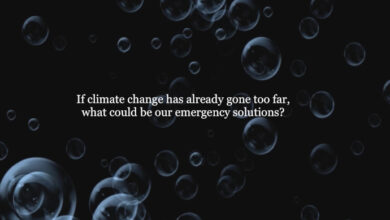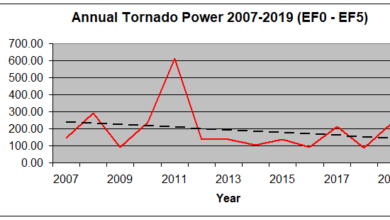Cliff Mass Weather Blog: Continued Major Errors and Misinformation In Seattle Times Climate Stories: Damaging and Unnecessary.

During the past weeks, profoundly flawed and error-filled stories on climate change have been headlined in the Seattle Times. Stories that can easily be demonstrated to have serious factual and interpretative errors.
Stories that grossly misinform Seattle Times readers and work against efforts to mitigate global warming.
![]()
Let me demonstrate the problem.
Saturday’s front-page story describes how because of urbanization “more than half of Seattle’s population resides in areas where daytime temperatures are over 8 degrees hotter than they would be naturally” and nearly 10% are in parts of the city recording an increase of over 12 degrees.”
The figure below was found in the Seattle Times story, and was based on a report from climate advocacy group, Climate Central. The “angle” of the story is how the growth of the city and loss of trees are greatly warming the environment.

This figure is obviously very wrong.
First, while temperatures should be in degrees, the colors say percent. But that is the least of the problem with this figure. The areas of warmth are all wrong. Tree-lined areas near Lake Washington are among the warmest. Downtown Seattle, near very cool Elliot Bay, is VERY hot. Tree-covered south Mercer Island is warm.
Anyone, who has studied local temperature variations knows this map is in error.
Let me explain how they got it wrong. Below is the same map from the Climate Central report used by the Seattle Times. It notes that hat 184 THOUSAND PEOPLE feel 8F or more warmer due to “urban heat spots.” Simply nonsense.
I looked at the and was stunned….their warmest temperatures were centered over LAKE WASHINGTON. The Seattle Times did not show this obvious error in their source. Clearly, Climate Central used a problematic surface map that did not know about our lakes.
But is worse than that. I carefully reviewed the “Methodology” section and realized the approach was flawed. The “researchers” ran a simple model of the interaction of the surface with the atmosphere, BUT NEGLECTING ANY INFORMATION ABOUT THE REGIONAL WIND CIRCULATIONS and other critical weather forcings (such as the effects of air blowing in over cold water). Actual surface temperatures were not used.
Seattle’s heat island is greatly mitigated by the presence of Puget Sound, the Strait, and the Pacific Ocean. There is a reason that Seattle’s summer temperatures are far milder than Portland’s.
To see how wrong the Seattle Times/Climate Central map is, consider the temperatures on the hottest day of the summer (July 5) in Seattle (see below).
Totally different than the Seattle Times map. Temperatures ranged from the 70s near the water to mid to upper 80s away from the water. No huge heating over Lake Washington. The warmest temperatures are in more rural areas (mid-90s). Downtown Seattle is NOT a huge hot spot as pushed by the Seattle Times. Their map is simply wrong. Urbanization is not making some Seattle locations 12F warmer than rural areas.
The truth is that a small reduction (or addition) in tree cover in Seattle will have a very modest influence on temperature because of Puget Sound, our mountains, and the local winds during summer. As an aside, I wish the Seattle Times would report on the effects of the construction of the third runway and urbanization around SeaTac Airport on the temperatures from the airport.
Ticks and Climate Change
Another deceptive Seattle Times story this week suggested that climate change could be making the tick problem worse in the Northwest.
This article is a study of hyping a threat that does not exist in order to get folks worried about climate change.
The article begins with the ominous note that “bloodsuckers are on the move in the Northwest” and notes that “warming trends, exacerbated by climate change, are creating a more hospitable environment for the parasites” in the Northwest.
However, the article provides no evidence that ticks have become more of a problem in the Northwest. And it certainly shows no evidence that climate change is causing a tick problem.
Hot, dry weather is bad for ticks, which would increase with all the heatwaves predicted by Seattle Times stories. The writer does not mention this important element, which would work against an invasion of the feared “bloodsuckers.”
Finally, milder winter temperatures (November through March) plausibly might encourage winter ticks.
So have winter temperatures in our region warmed substantially over the past? Below are the temperatures over the Puget Sound lowlands over the past 40 years, when global warming has been most noticeable (see below).
Little warming is evident, a situation promoted by the nearby, slow-to-warm, Pacific Ocean.
The threat of “bloodsuckers” is clearly not changing much over our region and may, in fact, decline. Scarester articles like this are not constructive.
Killing Older Women Women in Switzerland?
Many of the over-the-top, crazy climate stories in the Seattle Times are reprinted from the NY Times, Washington Post, and other media. Today this was a story about dying older women in Switzerland.
Amazingly, the article claims that the Swiss temperatures in July have warmed by 35F since the 1800s, with July 2023 temperatures being 60F. I repeat 35F increase (or about 19C), which means the mean temperature in July would have been 25F…..well below freezing in July.
This is nuts. But don’t believe me. Here are the official statistics from the Swiss government. A 2.12 C increase. That is about 3.8F. NOT 35F.
Irresponsible Climate Journalism at the Seattle Times
What is happening at the Seattle Times is both sad and disappointing.
I could have provided you will many more problematic, non-factual articles from the newspaper (for example, the bogus claims that global warming is causing a marine heatwave over the northeast Pacific). Stories that are intended to hype climate change and scare people.
Human-caused global warming is a slowly growing, modest problem. Our planet has warmed by around 2F during the past 50 years and human emissions are probably the dominant cause.
Hyping and exaggerating this problem may be popular in some “progressive” circles, but it is counterproductive.
A democratic society like ours can not function when the media is providing inaccurate information to citizens, and I am afraid that the Seattle Times has decided that advocacy is more important than providing factual information.
There was a time when the Seattle Times employed exemplary science reporters, such as Hill Williams and Dietra Henderson. Reporters dedicated to getting the science right, without any political or advocacy angle. Unfortunately, those days are over at the Seattle Times.
Monday Update
Unbelievably, there was ANOTHER front-page climate article in the Seattle Times today that was essentially wrong, one that confuses weather and climate:
The article claims that drier conditions this year reduced hydropower and is a sign of climate change (global warming). Strangely, the article suggests that wetter conditions in California, as observed this year, are also a sign of climate change. Earlier articles in the ST suggested drying in CA is a sign of climate change.
The truth is that there is no long-term trend in precipitation over our region. If anything, it is going up.
PLEASE: Do not leave me comments calling me names, like “denier” or accusing me of taking money from oil companies. If you think I got some fact wrong, let me know where you think my science is wrong, and provide the data/publications to support your claim.













